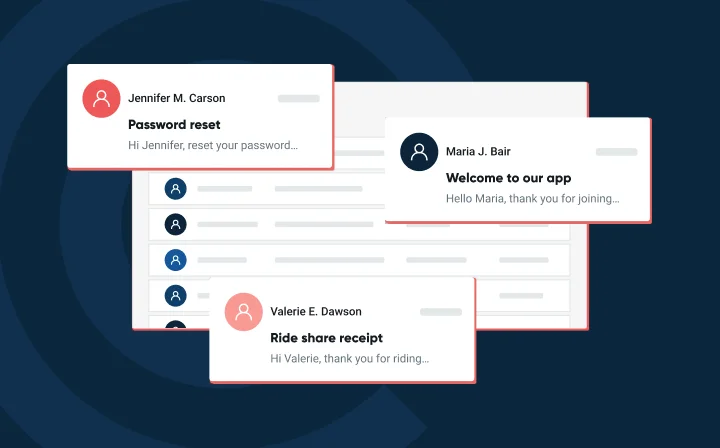Setting the record straight: What people get wrong (and right!) about Mailgun


Search “Mailgun” on Reddit or certain forums, and you’ll stumble into a rabbit hole of strong opinions: “It’s too technical.” “Too many emails go to spam.” “Support is a joke.” Sound familiar?
Here’s the truth: some of the criticism around Mailgun is outdated, misinformed, or missing key context. And a lot of it overlooks what Mailgun actually excels at – including deliverability, reliability, and a platform built with developers in mind.
So let’s set the record straight. In this post, we’ll walk through common myths about Mailgun, show you what’s fact vs. fiction, and give you a clearer picture of what Mailgun actually offers – and why it might just be the right fit for your email program.
Truth: Deliverability depends on the sender, not just the platform
Let’s say your emails are going straight to spam. It’s easy to blame your provider, but that’s like blaming your oven when your cake doesn’t rise. Deliverability isn’t something you can outsource entirely; it’s a shared responsibility between the platform and the sender.
Yes, Mailgun sends billions of emails per month. But inbox placement still depends on how you send: Are you using proper authentication? Are your email lists clean? Are you warming up IPs and domains correctly?
Mailgun is purpose-built to help senders improve deliverability, with features like:
In short, yes, Mailgun gives you the infrastructure and insight to land in the inbox – but it’s not magic. If you’re blasting cold lists or skipping authentication, no ESP can save you. The good news? When you follow best practices, Mailgun doesn’t just keep up – it leads.
According to our 2025 State of email deliverability report, Mailgun customers who followed best practices saw industry-leading inbox rates, often outperforming ESPs that make louder promises.
Truth: Yes, it’s dev-first, but not dev-only
At some point, someone decided that Mailgun was a secret club for backend engineers, and if you didn’t speak fluent cURL, you weren’t invited. The myth stuck. But here’s the reality: while Mailgun does cater to developers (very well, in fact), it’s no longer a command-line-only experience.
These days, a marketer can log in, run a preview test, check performance metrics, and even validate a list – no code, no API keys, no stress. Prefer to stay hands-off? A developer can spin up a webhook to your CRM of choice for seamless data visibility. And if your team includes both devs and non-devs? Even better. Mailgun gives each what they need without stepping on toes.
Mailgun’s developer roots run deep, but it’s also packed with tools that make life easier for teams of all skill levels, no terminal required – such as:
Is Mailgun dev-first? Absolutely. But if you’re a marketer who just wants to make sure the campaign doesn’t get flagged by Gmail, we have your back as well.
Mailgun’s hybrid approach stands out. Platforms like Resend focus solely on developers, whereas others target marketers only. Mailgun brings both together, without dumbing things down or overcomplicating them.
Truth: Many features are available, if you know where to look
Saying that Mailgun is missing features feels like showing up at a restaurant, glancing at the appetizers, and walking out saying “They don’t serve food.” Mailgun absolutely has the features – but like a fine-tuned API, they don’t always jump out at you unless you know where to click.
Some of the confusion stems from plan differences. Other times, it’s from users expecting one-click campaign builders (which Mailgun isn’t). But if you’re running a serious email program – transactional or marketing – the ingredients are all here.
Mailgun supports modern email programs from end to end; you just need to know where to look. Here’s what’s already built in:
Mailgun isn’t built to be a drag-and-drop design tool – that’s what our sister platform Mailjet does best. Mailgun’s job is simpler and stronger: sending email that delivers quickly, scales with your business, and hits the inbox every time.
Some features vary by plan, like email validation credits or advanced analytics. So before you file a support ticket asking where something you need is, check the pricing page. You might already have it (or be able to get it in one click).
Truth: Analytics is a power feature, not a flaw
We get it: not everyone wants to sift through delivery logs or parse SMTP codes. But saying Mailgun’s analytics are “too hard” is like saying a microscope is “too detailed.” The information is there because you might actually need it someday, especially when something breaks.
And when you’re sending mission-critical emails – receipts, alerts, password resets – having the full picture can save your skin. You don’t want a dashboard that just says “sent.” You want one that says where, when, how, and what happened after.
Mailgun’s analytics aren’t just dashboards; they’re diagnostic tools designed for teams that need answers, not just charts. We give you:
Yes, Mailgun’s analytics go deep. That’s the point. They’re not for vanity metrics; they’re for diagnosing, optimizing, and proving that your emails are doing what they’re supposed to do.
If you’ve ever tried to explain to your boss why open rates dropped without the data to back it up, you’ll appreciate just how detailed Mailgun’s analytics really are.
Truth: Mailgun customers aren’t flying solo
Some of the more cynical Reddit threads make it sound like signing up for Mailgun is like being dropped in the wilderness with a rusty compass and a stack of outdated support docs. And unless you’re a huge Survivor fan like this blog’s author, that probably sounds intimidating. But it’s also not accurate.
While support experiences do depend on your plan (as they do with pretty much every SaaS platform), Mailgun gives teams access to real help, from deliverability pros to account managers. They might not always be at your beck and call, but there are actual humans on the other end of your support form.
Mailgun’s support ecosystem is deeper than most people realize – and it scales with your needs:
And if you’re on a lower-tier plan? You still get solid documentation and a responsive support team – just maybe not white-glove Slack access to a deliverability engineer. (That’s fair, right?)
If email is mission-critical for you – think product notifications, security alerts, or high-volume campaigns – a plan with a TAM is worth its weight in gold. They’ll spot issues before they cost you revenue.
Not all the internet takes are wrong. In fact, the folks who’ve really kicked the tires on Mailgun tend to land on the same conclusion: this platform is a serious tool for serious senders.
Yes, Mailgun is technical. Yes, it’s powerful. But those aren’t drawbacks – they’re the reason people choose it. Especially when deliverability is make-or-break.
So yes, the hot takes are sometimes hot for a reason. But the smartest ones tend to boil down to this: Mailgun’s power is real… if you’re ready to use it.
Let’s face it: if you’ve ever searched for ESP advice online, you’ve seen the spicy takes. Some are fair. Some are funny. Some are, well, just user error. Let’s break a few of them down.
“Mailgun support is MIA.”

Response: It depends on your plan. Free and entry-level tiers get standard support; higher tiers unlock priority queues, live chat, and Technical Account Managers. If you need fast help and proactive advice, upgrading is worth it.
“All my emails went to spam.”

Response: Were you using SPF and DKIM? Did you validate your list? Did you warm your domain? Mailgun provides the tools, but inbox placement still depends on how you send. No ESP can fix poor sender hygiene.
“It’s too technical.”

Response: And yet, here you are on /r/sysadmin. 😉
Joking aside, Mailgun’s UI has grown up. If you don’t want to touch code, you don’t have to. But if you do? It’s all there, waiting.
Is Mailgun the right platform for every sender? Certainly not. If you want a drag-and-drop email builder with pre-written subject lines and emoji A/B tests, you’ve got plenty of options elsewhere.
But if you need a reliable, flexible, developer-grade email platform that scales with your business, Mailgun delivers. Literally.
A lot of the flak Mailgun gets comes down to two things: outdated impressions or underutilized features. When you lean in – set things up right, follow best practices, and use the resources provided – Mailgun can become one of the most powerful tools in your messaging arsenal.